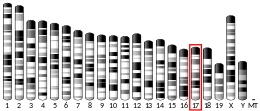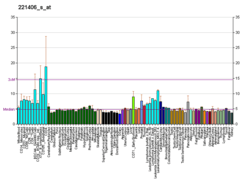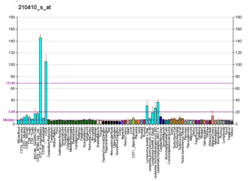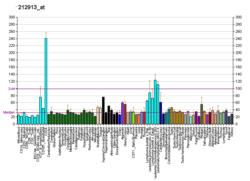MSH5
MutS protein homolog 5 is a protein that in humans is encoded by the MSH5 gene.[5][6][7][8]
Function
This gene encodes a member of the mutS family of proteins that are involved in DNA mismatch repair or meiotic recombination processes. This protein is similar to a Saccharomyces cerevisiae protein that participates in meiotic segregation fidelity and crossing-over. This protein forms heterooligomers with another member of this family, mutS homolog 4. Alternative splicing results in four transcript variants encoding three different isoforms.[8]
Mutations
Mice homozygous for a null Msh5 mutation (Msh5-/-) are viable but sterile.[9] In these mice, the prophase I stage of meiosis is defective due to the disruption of chromosome pairing. This meiotic failure leads, in male mice, to diminution of testicular size, and in female mice, to a complete loss of ovarian structures.
A genetic investigation was performed to test women with premature ovarian failure for mutations in each of four meiotic genes.[10] Among 41 women with premature ovarian failure two were found to be heterozygous for a mutation in the MSH5 gene; among 34 fertile women (controls) no mutations were found in the four tested genes.
These findings in mouse and human indicate that the MSH5 protein plays an important role in meiotic recombination.
In the worm Caenorhabditis elegans, the MSH5 protein is required during meiosis both for normal spontaneous and for gamma-irradiation induced crossover recombination and chiasma formation.[11] Meiotic recombination is often initiated by double strand breaks. MSH5 mutants retain the competence to repair DNA double-strand breaks that are present during meiosis, but they accomplish this repair in a way that does not lead to crossovers between homologous chromosomes.[11] The known mechanism of non-crossover recombinational repair is called synthesis dependent strand annealing (see homologous recombination). MSH5 thus appears to be employed in directing the recombinational repair of some double-strand breaks towards the cross over option rather than the non-cross over option.
Interactions
MSH5 has been shown to interact with MSH4.[6][12][13]
References
- ENSG00000235569, ENSG00000204410, ENSG00000230293, ENSG00000235222, ENSG00000237333, ENSG00000227314, ENSG00000233345 GRCh38: Ensembl release 89: ENSG00000230961, ENSG00000235569, ENSG00000204410, ENSG00000230293, ENSG00000235222, ENSG00000237333, ENSG00000227314, ENSG00000233345 - Ensembl, May 2017
- GRCm38: Ensembl release 89: ENSMUSG00000007035 - Ensembl, May 2017
- "Human PubMed Reference:". National Center for Biotechnology Information, U.S. National Library of Medicine.
- "Mouse PubMed Reference:". National Center for Biotechnology Information, U.S. National Library of Medicine.
- Her C, Doggett NA (Aug 1998). "Cloning, structural characterization, and chromosomal localization of the human orthologue of Saccharomyces cerevisiae MSH5 gene". Genomics. 52 (1): 50–61. doi:10.1006/geno.1998.5374. PMID 9740671.
- Winand NJ, Panzer JA, Kolodner RD (Oct 1998). "Cloning and characterization of the human and Caenorhabditis elegans homologs of the Saccharomyces cerevisiae MSH5 gene". Genomics. 53 (1): 69–80. doi:10.1006/geno.1998.5447. PMID 9787078.
- Snowden T, Shim KS, Schmutte C, Acharya S, Fishel R (Jan 2008). "hMSH4-hMSH5 adenosine nucleotide processing and interactions with homologous recombination machinery". The Journal of Biological Chemistry. 283 (1): 145–54. doi:10.1074/jbc.M704060200. PMC 2841433. PMID 17977839.
- "Entrez Gene: MSH5 mutS homolog 5 (E. coli)".
- Edelmann W, Cohen PE, Kneitz B, Winand N, Lia M, Heyer J, Kolodner R, Pollard JW, Kucherlapati R (Jan 1999). "Mammalian MutS homologue 5 is required for chromosome pairing in meiosis". Nature Genetics. 21 (1): 123–7. doi:10.1038/5075. PMID 9916805.
- Mandon-Pépin B, Touraine P, Kuttenn F, Derbois C, Rouxel A, Matsuda F, Nicolas A, Cotinot C, Fellous M (Jan 2008). "Genetic investigation of four meiotic genes in women with premature ovarian failure". European Journal of Endocrinology. 158 (1): 107–15. doi:10.1530/EJE-07-0400. PMID 18166824.
- Kelly KO, Dernburg AF, Stanfield GM, Villeneuve AM (Oct 2000). "Caenorhabditis elegans msh-5 is required for both normal and radiation-induced meiotic crossing over but not for completion of meiosis". Genetics. 156 (2): 617–30. PMC 1461284. PMID 11014811.
- Her C, Wu X, Griswold MD, Zhou F (Feb 2003). "Human MutS homologue MSH4 physically interacts with von Hippel-Lindau tumor suppressor-binding protein 1". Cancer Research. 63 (4): 865–72. PMID 12591739.
- Bocker T, Barusevicius A, Snowden T, Rasio D, Guerrette S, Robbins D, Schmidt C, Burczak J, Croce CM, Copeland T, Kovatich AJ, Fishel R (Feb 1999). "hMSH5: a human MutS homologue that forms a novel heterodimer with hMSH4 and is expressed during spermatogenesis". Cancer Research. 59 (4): 816–22. PMID 10029069.
Further reading
- Her C, Zhao N, Wu X, Tompkins JD (2007). "MutS homologues hMSH4 and hMSH5: diverse functional implications in humans". Frontiers in Bioscience. 12: 905–11. doi:10.2741/2112. PMID 17127347.
- Sargent CA, Dunham I, Campbell RD (Aug 1989). "Identification of multiple HTF-island associated genes in the human major histocompatibility complex class III region". The EMBO Journal. 8 (8): 2305–12. doi:10.1002/j.1460-2075.1989.tb08357.x. PMC 401163. PMID 2477242.
- Albertella MR, Jones H, Thomson W, Olavesen MG, Campbell RD (Sep 1996). "Localization of eight additional genes in the human major histocompatibility complex, including the gene encoding the casein kinase II beta subunit (CSNK2B)". Genomics. 36 (2): 240–51. doi:10.1006/geno.1996.0459. PMID 8812450.
- Edelmann W, Cohen PE, Kneitz B, Winand N, Lia M, Heyer J, Kolodner R, Pollard JW, Kucherlapati R (Jan 1999). "Mammalian MutS homologue 5 is required for chromosome pairing in meiosis". Nature Genetics. 21 (1): 123–7. doi:10.1038/5075. PMID 9916805.
- Bocker T, Barusevicius A, Snowden T, Rasio D, Guerrette S, Robbins D, Schmidt C, Burczak J, Croce CM, Copeland T, Kovatich AJ, Fishel R (Feb 1999). "hMSH5: a human MutS homologue that forms a novel heterodimer with hMSH4 and is expressed during spermatogenesis". Cancer Research. 59 (4): 816–22. PMID 10029069.
- Xie T, Rowen L, Aguado B, Ahearn ME, Madan A, Qin S, Campbell RD, Hood L (Dec 2003). "Analysis of the gene-dense major histocompatibility complex class III region and its comparison to mouse". Genome Research. 13 (12): 2621–36. doi:10.1101/gr.1736803. PMC 403804. PMID 14656967.
- Anderson NL, Polanski M, Pieper R, Gatlin T, Tirumalai RS, Conrads TP, Veenstra TD, Adkins JN, Pounds JG, Fagan R, Lobley A (Apr 2004). "The human plasma proteome: a nonredundant list developed by combination of four separate sources". Molecular & Cellular Proteomics. 3 (4): 311–26. doi:10.1074/mcp.M300127-MCP200. PMID 14718574.
- Snowden T, Acharya S, Butz C, Berardini M, Fishel R (Aug 2004). "hMSH4-hMSH5 recognizes Holliday Junctions and forms a meiosis-specific sliding clamp that embraces homologous chromosomes". Molecular Cell. 15 (3): 437–51. doi:10.1016/j.molcel.2004.06.040. PMID 15304223.
- Yi W, Wu X, Lee TH, Doggett NA, Her C (Jul 2005). "Two variants of MutS homolog hMSH5: prevalence in humans and effects on protein interaction". Biochemical and Biophysical Research Communications. 332 (2): 524–32. doi:10.1016/j.bbrc.2005.04.154. PMID 15907804.
- Lee TH, Yi W, Griswold MD, Zhu F, Her C (Jan 2006). "Formation of hMSH4-hMSH5 heterocomplex is a prerequisite for subsequent GPS2 recruitment". DNA Repair. 5 (1): 32–42. doi:10.1016/j.dnarep.2005.07.004. PMID 16122992.
- Rual JF, Venkatesan K, Hao T, Hirozane-Kishikawa T, Dricot A, Li N, Berriz GF, Gibbons FD, Dreze M, Ayivi-Guedehoussou N, Klitgord N, Simon C, Boxem M, Milstein S, Rosenberg J, Goldberg DS, Zhang LV, Wong SL, Franklin G, Li S, Albala JS, Lim J, Fraughton C, Llamosas E, Cevik S, Bex C, Lamesch P, Sikorski RS, Vandenhaute J, Zoghbi HY, Smolyar A, Bosak S, Sequerra R, Doucette-Stamm L, Cusick ME, Hill DE, Roth FP, Vidal M (Oct 2005). "Towards a proteome-scale map of the human protein-protein interaction network". Nature. 437 (7062): 1173–8. doi:10.1038/nature04209. PMID 16189514.
- Sekine H, Ferreira RC, Pan-Hammarström Q, Graham RR, Ziemba B, de Vries SS, Liu J, Hippen K, Koeuth T, Ortmann W, Iwahori A, Elliott MK, Offer S, Skon C, Du L, Novitzke J, Lee AT, Zhao N, Tompkins JD, Altshuler D, Gregersen PK, Cunningham-Rundles C, Harris RS, Her C, Nelson DL, Hammarström L, Gilkeson GS, Behrens TW (Apr 2007). "Role for Msh5 in the regulation of Ig class switch recombination". Proceedings of the National Academy of Sciences of the United States of America. 104 (17): 7193–8. doi:10.1073/pnas.0700815104. PMC 1855370. PMID 17409188.
- Szafranski K, Schindler S, Taudien S, Hiller M, Huse K, Jahn N, Schreiber S, Backofen R, Platzer M (2007). "Violating the splicing rules: TG dinucleotides function as alternative 3' splice sites in U2-dependent introns". Genome Biology. 8 (8): R154. doi:10.1186/gb-2007-8-8-r154. PMC 2374985. PMID 17672918.






